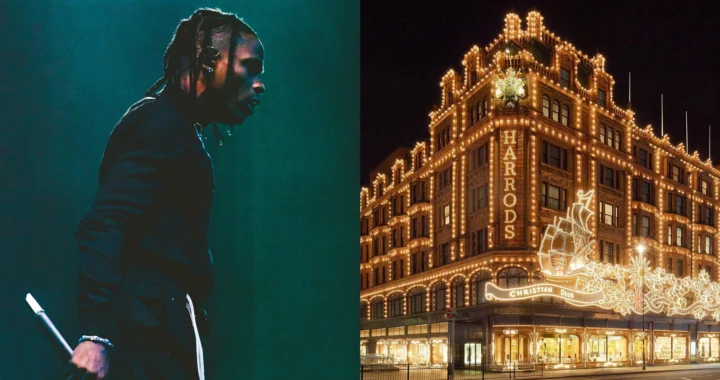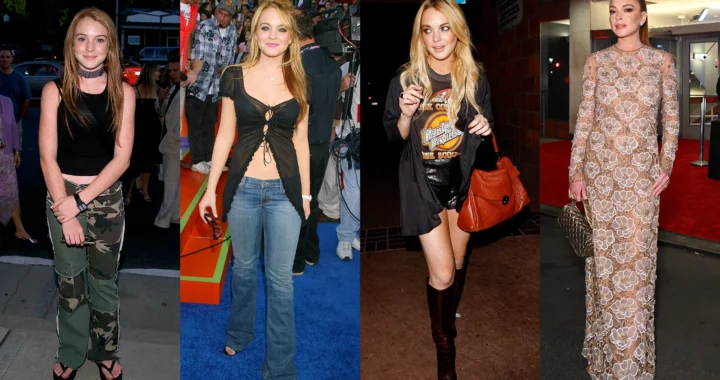Ahead of the Flemish designer’s hotly anticipated London show, we unpack the fashion legend’s longstanding love of the UK.
The weather’s shit, inflation’s rising and our political system has all but crumbled. Like the punchline of a bad joke your dad keeps telling, Britain is only getting worse. Add this to a woeful record of climate desecration, colonial plunder and neoliberal catastrophe, and you might wonder: what on earth has possessed Raf Simons to choose our drizzly isles as the location for his SS23 show? Yes, in news that has lifted the spirits of the UK’s fashion fanatics, the menswear magician and Prada co-creative director will finally touching down in London, after initially having to postpone the show from its original London Fashion Week date, bringing a silver lining to the otherwise dark clouds that loom overhead.
Doom-mongering aside, though, the thing that fuels Raf’s longstanding love for Britain still warrants the prefix of ‘Great’. It’s the culture – the dizzying thump of New Order’s “Blue Monday”, the patter of stomping Dr. Martens or the spine-tingling chill of Aphex Twin’s “Helisophan”.
There are a fair few things that explain the legendary designer’s Anglophilia. For starters, he hails from Flanders, a region that has more in common with The UK than you might think. Gloomy skies and a shared love of chips aside, they’re joined by a rich history of cultural exchange. Flanders, after all, is the birthplace of new beat, a genre that’s a direct descendent of British new wave – both of which Raf has extensively referenced in his work. The rise of new beat laid the foundations for the hardcore raves – where Raf spent (spends?) many a night – that flourished in cities across Britain and Belgium in the 90s.
Still, one thing that no doubt fuels Raf’s admiration for Britain is the fact that, for all its troubles, past and present, it has consistently proven to be a source of era-defining creativity, producing some of the greatest music and style movements of all time – from soul boys and skins to mods, punks and glam rockers, references to which pepper the designer’s oeuvre. Here, to toast his upcoming debut in the Big Smoke, we unpack the best of British culture according to Raf Simons.
David Bowie
Pocked with adolescent angst, Raf’s opening collections were resolutely grungy – a far cry from the glitzy world of David Bowie. However, the glam rock icon has served as a longstanding muse for Raf, providing soundtracks (see Raf Simons SS99 for a psychedelic medley of Bowie’s classics) and inspiration for some of his most memorable designs. “The earliest reference I can think of that I love are the t-shirts Raf made with David Bowie on them in his very first collections,” says esteemed Raf Simons archivist, David Casavant, referring to a peach vest from SS96, screen-printed with Bowie’s brooding Aladdin Sane album cover.
This obsession with the South London boy is no secret, though. In an interview for Fred Perry, Raf cites Bowie as a personal icon, wishing he had written the seminal “Heroes” himself. A permanent fixture in Raf’s collections, Bowie would also soundtrack Dior’s SS15 couture collection, which was named after Ziggy Stardust’s “Moonage Dream”. Replete with nods to the Starman via sequined jumpsuits and wipe-clean patent leather, it reimagined couture beyond Monsieur Dior’s femme fleur, presenting something camper, sexier and more irreverent that appealed to Raf diehards and Dior’s top-tier clients alike. Now, that’s range. Oh, and the closing track for Raf’s debut collection at Calvin Klein? You guessed it. A Bowie ballad with a piquant message aimed at then-president Donald Trump: “This is not America”.
Post-Punk, New Wave & Peter Saville
As Raf’s brand became more established, he gradually introduced edgier tastes. “Later in AW01, Raf put patches of Bowie along with Manic Street Preachers and Joy Division ones on the sweatshirts,” David Casavant remembers of the Riot! Riot! Riot! collection. The latter was just a taste of what was to come. Eventually, Raf worked directly with graphic designer Peter Saville, the man responsible for Joy Division’s – plus, many of Factory Records’ – album artworks. The fruits of this relationship? Some of Raf’s most hotly coveted items.
Take the fishtail parkas of AW03, for example. Synonymous with Britpop and mod movie Quadrophenia, this style of coat was already steeped in subcultural clout before Raf turned his hands to it. When he pasted four with Saville-designed covers from New Order and Merseyside’s new wave group Orchestral Manoeuvres in the Dark, they took on a magical quality. Paying homage to Northern British music, these jackets now fetch extortionate prices on specialist resale sites like Grailed, and featured at curator Lou Stoppard’s North exhibition in 2017 at Somerset House. Harking back to a pre-internet era where record sleeves held added lustre for small-town kids with limited access to subcultural scenes, Raf’s relationship with Saville remains strong to this day. When appointed creative director of Calvin Klein in 2016, Raf knew who to call for the logo redesign.
Raf the Raver
Just like Peter Saville – who’s as well known for designing the identity for The Hacienda, the Manchester acid house haven, as he is for his new wave album covers – Raf also harbours a deep love for the sweat-hazed world of dance music. “I’m not so rock and roll. I’m more techno,” he even told the Wall Street Journal in 2011. More recently, this manifested in a Prada-hosted rave in the basement of Tate Modern – co-organised with techno titan Richie Hawtin, the shindig brought together some of London’s finest selectors, including Overmono, HAAi and OK Williams. Just one of many instances that support our suspicion: Raf loves a good knees-up.
It’s a passion that has made itself felt in his shows, too. For Jil Sander AW06, Raf opted for the seamless breakbeats of British producer Aphex Twin to complement a minimalist offering of boyish tailoring and exquisitely simplified separates. Later, for SS09 menswear, Raf introduced an unlikely audience of industry bods including Anna Wintour and Cathy Horyn to trippy tunes from The Orb, a duo that cut their teeth as dub DJs in London before concocting psychedelic ambient tracks popular with ravers coming down from a night out. A out-of-the-box creative decision, but one that eschewed runway rules for the better. By the time of Dior’s AW15 womenswear collection, the combination of the synthy slap of Throbbing Gristle’s “Hot on the Heels of Love” and dominatrix-y latex looks were only to be expected.
Beyond the music, the most apparent example of Raf’s infatuation with UK club culture has to be his Raf Simons SS07 show, set to a backdrop of artist Mark Leckey’s Fiorucci Made Me Hardcore, a filmic journey from seventies Northern Soul to nineties hardcore rave. “It wasn’t a collab,” Mark says. “He just played Fiorucci, which for me, is in the Creative Commons and free for anyone to use. I like Raf, so I was happy he used it.” Here, Raf was the fanboy, and he has continued to be on in seasons since. The grainy static of Leckey’s found footage informed the knitwear in his SS12 collection for Jil Sander, and for Raf Simons SS16, he even commissioned Michel Gaubert to doctor its euphoric soundbites for a serotonin-releasing soundtrack. If his statement for the upcoming SS23 show is anything to go by, we’re in for more of the same: “Can’t wait to see you and dance the night away.”
Fred Perry
A hallmark of British subculture and one of the key brands to receive an honorary mention in Fiorucci Made Hardcore, Fred Perry has uniformed many of Raf’s favourite style tribes. First teaming up his namesake label for AW08, the collaboration saw Raf deploy some of his distinctive design tropes – patching, tactically placed metal hardware and full-render photographic transfers – in a salute to the Laurel Wreath’s indelible mark on youth culture. For SS09, the knitted polos of ska and two-tone listeners took centre stage; for AW19, a more direct reference: Gavin Watson’s gritty skinhead studies. Between them, a sartorial history of style as resistance in post-war Britain emerges.
For AW22, Fred Perry and Raf spotlight northern soul, a genre that’s notable for the cultural cross-pollination it brought about, bringing rare Black soul records to predominantly white, working-class dancehalls of Blackpool, Wigan and Stoke-on-Trent. Honouring the Motown B-sides DJs would spin, the collection is patchworked with record stickers and badges signifying dancehall allegiances – all set atop uber-sharp shirting. On the legs? Wide-hemmed trousers that echoed the original Oxford bags soulboys wore while shuffling in Wigan Casino.
Tasked by Fred Perry to shoot the AW22 collection, creative consultancy Cold Archive channelled these ideas into a dynamic shoot. “I was aware of both brands’ pedigrees and subcultural connotations and simply connected their existing lineage to a contemporary subculture that the brands had a part in inspiring,” explains Cold Archive’s creative director, Lewis James Dixon. “You can see themes of youthful exuberance, the chaos of the city, and the excitement belonging to a subculture brings in our visuals.” As for the cast? A crew of kids immersed in today’s underground scenes. “We strived to include the people that actually wear these clothes,” Lewis says. New climes, same iconic polo.
Dr. Martens
Can you really talk about British subcultures without paying Northampton’s rubber-soled powerhouse its dues? First pairing up with Raf Simons for an SS09 capsule of red-lined 1461 oxfords in navy, light grey and black patent – plus a chaotic boot-cum-sandal (here for it!) – Dr. Martens would work with Simons once more for AW09 before a ten-year hiatus. The official skinhead, punk and indie kid’s footwear brand of choice, the bootmaker was an ideal match for Raf.
For the collaboration’s return for AW19 with a 1461 steel-toed shoe no less at home on a worksite than at a London squat party, DMs took style cues from the brand’s early subcultural adopters while mirroring Raf’s eye for detail. “We wanted to give them a rough edge instead of a pristine cut as a nod to the punks who used to customise and personalise their outfits,” says Dr Martens’ Global Creative Director, Darren McKoy. Followed up for AW20 with a 1460 boot decked with steel-hooks – not dissimilar to the kinky steel rings in Raf’s own SS19 collection – the collab was ultimately about a DIY sensibility. “We tried multiple hook executions before we got it right as what we wanted to create was something you can personalise by adding your own details or charms to make it uniquely yours,” explains Darren. Like the safety-pinned garments and piercing parlours found in 80s Camden, industrial materials and hardwearing clobber are reworked with a by-any-means creativity – an approach that’s characteristic of both British subcultural style and Raf’s style.
Tasked by Fred Perry to shoot the AW22 collection, creative consultancy Cold Archive channelled these ideas into a dynamic shoot. “I was aware of both brands’ pedigrees and subcultural connotations and simply connected their existing lineage to a contemporary subculture that the brands had a part in inspiring,” explains Cold Archive’s creative director, Lewis James Dixon. “You can see themes of youthful exuberance, the chaos of the city, and the excitement belonging to a subculture brings in our visuals.” As for the cast? A crew of kids immersed in today’s underground scenes. “We strived to include the people that actually wear these clothes,” Lewis says. New climes, same iconic polo.






